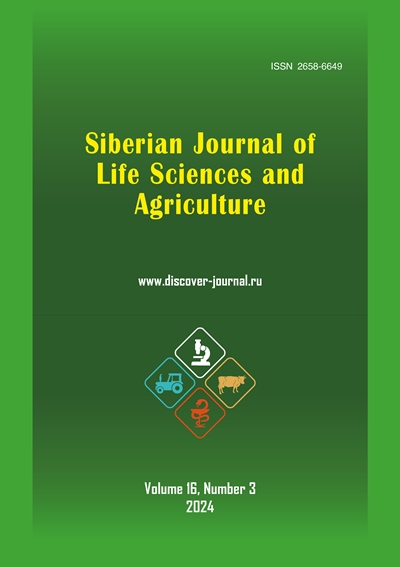НЕКОТОРЫЕ БИОЛОГИЧЕСКИЕ И ЭКОЛОГИЧЕСКИЕ ОСОБЕННОСТИ HYPODERMA LATREILLE, 1818 В ТАВУШСКОЙ ОБЛАСТИ АРМЕНИИ
Аннотация
Обоснование. Гиподерматоз крупного рогатого скота – хронический энтомоз, вызываемый паразитируемыми в организме животных личинками подкожных оводов. Болезнь распространена более чем в 55 странах мира и причиняет большой экономический ущерб. Болезнь относится к паразитозам с определенным зоонозным потенциалом.
Цель. Изучить биологические и экологические особенности подкожных оводов, являющихся эпизоотологическими детерминантами гиподерматоза крупного рогатого скота в Тавушской области Армении.
Материалы и методы. Наблюдения проводили в Тавушской области, а эксперименты – в Исследовательском центре ветеринарии и ветеринарно-санитарной экспертизы Национального аграрного университета Армении. Половозрелых оводов помечали краской и выпускали на расстоянии 0,5-1,5 км от животноводческих ферм с последующим отловом насекомых на пастбище и на кожных покровах животных. В общей сложности было выпущено 275 насекомых. Активность оводов оценивали визуально, подсчитывая количество летающих в течение минуты насекомых в определенной точке в разное время суток, а также по степени беспокойства животных, вызванного оводами. Статистическая обработка экспериментальных данных проведена с помощью онлайн-калькуятора “Vassart.net”.
Результаты. Максимальная дальность полета самок Hypoderma bovis составила 12,1 км, а самок H. lineatum – 8,6 км. Самки H. bovis и H. lineatum демонстрировали различную пространственную и суточную активность, зависящую от времени года и высоты местности над уровнем моря. Весенняя генерация оводов более устойчива к низким температурам воздуха по сравнению с летней генерацией. Мягкое и влажное лето, а также увеличение поголовья скота обусловливает увеличение популяции подкожных оводов, тогда как высокая температура воздуха и высокая влажность почвы приводят к массовой гибели куколок оводов, развивающихся в почве.
Заключение. Приведенные в статье результаты исследований обнаруживают наличие широкого диапазона биоценотических факторов, определяющих эпизоотологические особенности гиподерматоза крупного рогатого скота в Тавушской области Республики Армения. На основании результатов исследования, а также с учетом природно-климатических условий Тавушской области, разработан план профилактики и борьбы с гиподерматозом крупного рогатого скота. План основан на пастбищной профилактике и периодических обработках животных инсектицидными препаратами.
Скачивания
Литература
References
Vasilevich F.I, Stasyukevich S.I. Pharmacotherapy and prevention of gadfly diseases in cattle and horses. Russian Veterinary Journal, 2013, no. 2, pp. 30-32.
Vatsaev S.V. Species composition, features of biology and distribution of causative agents of cattle hypodermosis in the Chechen Republic. Russian Journal of Parasitology, 2017, no. 1, pp. 23-27.
Glazunova A.A, Kustikova O.V, Lunina D.A. et al. Hypodermosis in cattle, diagnosis, treatment and prevention (review). Russian Journal of Parasitology, 2019, vol. 13, no. 4, pp. 83-90.
Mavrin N.A. Warble flies of cattle in the Western region of the Russian Federation: biology, control measures: Dissertation… Candidate of Biol. Sciences. Moscow, 2008, 140 p.
Nepoklonov A.A., Prokhorova I.A., Mavrin N.A. Control of warble flies and prevention of hypodermosis in cattle in Russia and abroad. Veterinaria Kubani [Veterinary of Kuban], 2011, no. 5, pp. 21-25.
Prikaz “O neotlozhnykh merakh po bor`be s podkozhnym ovodom, profilaktike i ozdorovleniyu krupnogo rogatogo skota i severnykh olenej ot gipodermatoza v Rossijskoj Federacii na 2008-2010 gg.” [Order "On urgent measures to combat the warble flies, prevention and rehabilitation of cattle and reindeer from hypodermosis in the Russian Federation for 2008–2010."]. Moscow: Ministry of Agriculture of the Russian Federation, 2008, 24 p.
Reshetnikov A.D, Barashkova A.I. Warble flies (Diptera: Hypodermatidae) as a problem of domestic animal husbandry: a review of scientific research. Agrarian Bulletin of the Urals, 2017, vol. 158, no. 4, pp. 48-51.
Smolyaninov Yu.I., Balyberdin B.N., Meltsov I.V. Analiz effektivnosti meropriyatii pri gipodermatoze krupnogo rogatogo skota [Analysis of effectiveness of measures in treating cattle hypodermosis]. Sibirskii vestnik sel’skokhozyaistvennoi nauki [Siberian Herald of Agricultural Science], 2019, vol. 49, no. 5, pp. 67-72.
Stepanova E. A. A new method for diagnostics of the cattle hypodermosis. Veterinary Pathology, 2005, no. 2, p. 96.
Ustinov A.M., Safiullin R.T., Safiullin R.R. et al. Fascioliasis and hypodermosis in cattle in the conditions of the Kaluga region. Russian Journal of Parasitology, 2017, no. 4, pp. 361-367.
Yatusevich A.I., Stasyukevich S.I., Yatusevich I.A. et al. Arachnoentomoses of domestic ruminants and hoofed animals. Vitebsk, 2006, 213 p.
Ahmed H., Afzal M.S., Mobeen M. et al. An overview on different aspects of hypodermosis: Current status and future prospects. Acta Trop., 2016, vol. 162, pp. 35-45. https://doi.org/10.1016/j.actatropica.2016.05.016
Ahmed H., Simsek S., Saki C.E., Kesik H.K., Kilinc S.G. Molecular Characterization of Hypoderma SPP. in Domestic Ruminants from Turkey and Pakistan. J Parasitol., 2017, vol. 103, issue 4, pp. 303-308. https://doi.org/10.1645/16-185
Bagherzadeh N.M., Behniafar H., Rahbari S., Valizadeh S. Prevalence of hypodermosis in cattle slaughtered in industrial slaughtered-house of Ardebil, Iran. Journal of Parasitic Diseases, 2016, vol. 40, pp. 1579-1582.
Becskei Z., Ilić T., Pavlićević N., et al. Hypodermosis in northern Serbia (Vojvodina). Macedonian Veterinary Review, 2016, vol. 39(1). https://doi.org/10.1515/macvetrev-2016-0072
Colwell D.D. Out of sight but not gone: Sero-surveillance for cattle grubs, Hypoderma spp., in western Canada between 2008 and 2010. Vet. Parasitol., 2013, vol. 197, issues 1-2, pp. 297-303. https://doi.org/10.1016/j.vetpar.2013.07.009
Darabus G., Tomoioaga V.D., Florea T., et al. Epidemiological Surveillance of Hypodermosis in Cattle from Romania. Pathogens, 2023, vol. 12, pp. 1077-1086. https://doi.org/10.3390/pathogens12091077
Fu Y., Li W., Duo H., et al. Genetic diversity and population genetics of the warble flies Hypoderma bovis and H. sinense in Qinghai Province, China. Parasites & Vectors, 2016, vol. 9, pp. 145-153. https://doi.org/10.1186/s13071-016-1416-6
El-Hawagry M.S.A., Abdel-Dayem M.S., Al Dhafer H.M. The family Oestridae in Egypt and Saudi Arabia (Diptera, Oestroidea). ZooKeys, 2020, vol. 947, pp. 113-142. https://doi.org/10.3897/zookeys.947.52317
Karatepe M., Simsek S., Karatepe B., et al. Seroprevalence of Hypodermosis in Cattle in Nigde Province of Turkey by Comparison of Commercial and Indirect-ELISA Methods. Israel J. Vet. Med., 2013, vol. 68, issue 1, pp. 38-42.
Otranto D., Johnson G., Syvrud K., et al. Treatment and control of bovine hypodermosis with ivermectin long-acting injection (IVOMEC® GOLD). Parasites & Vectors, 2016, vol. 9, pp. 551-556. https://doi.org/10.1186/s13071-016-1823-8
Panadero-Fontán R., Otranto D. Arthropods affecting the human eye. Vet Parasitol., 2015, vol. 208, issues 1-2, pp. 84-93. https://doi.org/10.1016/j.vetpar.2014.12.022
Pfister K., J.-L. Charbon J.-L. Die erfolgreiche Bekämpfung der Hypodermose in der Schweiz: Ein Blick zurück. Schweizer Archiv für Tierheilkunde, 2014, Band 156, Heft 1, ss. 39-43. https://doi.org/10.1024/0036-7281/a000545
Rehbeina S., Holsteb J.E., Smithc L.L., Lloydd J.L. The efficacy of eprinomectin extended-release injection against Hypoderma spp. (Diptera: Oestridae) in cattle. Vet. Parasitol., 2013, vol. 192, pp. 353-358. http://dx.doi.org/10.1016/j.vetpar.2012.11.042
Stepanova E.A., Yakubovskii M.V. Cattle hypodermosis as potentially dangerous zoonosis. Epidemiology, Immunobiology, Pharmacology, Sanitary Science: International Scientific and Practical Journal, 2011, vol. 2, pp. 20-25.
Vassart.net statistical online calculator. Available at: Fisher 2x4. http://vassarstats.net/fisher2x4.html
Webster K. A., Giles M., Dawson C. A competitive ELISA for the serodiagnosis of hypodermosis. Veterinary Parasitology, 1997, vol. 68, no 1-2, pp. 155-164. https://doi.org/10.1016/s0304-4017(96)01062-x
Wiszniewska-Łaszczych A., Wysok B., Wojtacka J., Sołtysiuk M. Effect of Mixed Invasions of Hypoderma bovis and Ostertagia ostertagi in Cattle on Milk Yield and Contents in Polish Dairy Farms. Animals, 2021, vol. 11, pp. 464-470. https://doi.org/10.3390/ani11020464
Yadav A., Katoch R., Khajuria J.K., Godara R., Agrawal R. Prevalence of Hypoderma lineatum in cattle of Jammu region. J. Par. Dis., 2013, vol. 37, pp. 196-198. https://doi.org/10.1007/s12639-012-0162-8
Список литературы
Василевич Ф. И., Стасюкевич С. И. Фармакотерапия и профилактика оводовых заболеваний крупного рогатого скота и лошадей // Российский ветеринарный журнал. 2013. № 2. С. 30-32.
Вацаев Ш. В. Видовой состав, особенности биологии и распространение возбудителей гиподерматоза крупного рогатого скота в Чеченской Республике // Российский паразитологический журнал. 2017. Вып. 1. С. 23-27.
Гиподерматоз крупного рогатого скота,диагностика, лечение и профилактика (обзор) / Глазунова А. А., Кустикова О. В., Лунина Д. А., Ильясов П. В. // Российский паразитологический журнал. 2019. Т. 13. № 4. С. 83-90.
Маврин Н. А. Подкожный овод крупного рогатого скота в Западном регионе Российской Федерации: биология, меры борьбы: Дисс. ... канд.биол. наук. М., 2008. 140 c.
Непоклонов А. А., Прохорова И. А., Маврин Н. А. Борьба с подкожными оводами и профилактика гиподерматоза крупного рогатого скота в России и за рубежом // Ветеринария Кубани. 2011. № 5. С. 21-25.
Приказ “О неотложных мерах по борьбе с подкожным оводом, профилактике и оздоровлению крупного рогатого скота и северных оленей от гиподерматоза в Российской Федерации на 2008-2010 гг.”. М.: Министерство сельского хозяйства Российской Федерации, 2008. 24 с.
Решетников А. Д., Барашкова А. И. Подкожный овод (Diptera, Hypodermatidae) как проблема отечественного животноводства: обзор научных исследований // Аграрный вестник Урала. 2017. Т. 158, № 04. С. 48-51.
Смолянинов Ю.И., Балыбердин Б. Н., Мельцов И.В. Анализ эффективности мероприятий при гиподерматозе крупного рогатого скота // Сибирский вестник сельскохозяйственной науки. 2019. Т. 49, № 5. С. 67-72. https://doi.org/10.26898/0370-8799-2019-5-9
Степанова Е. А. Новый метод диагностики гиподерматоза крупного рогатого скота // Ветеринарная патология. 2005. № 2. С. 96.
Фасциолез и гиподерматоз крупного рогатого скота в условиях Калужской области / Устинов А.М., Сафиуллин Р.Т., Сафиуллин Р.Р., Шибитов С.К. // Российский паразитологический журнал. 2017. Вып. 4. С. 361-367.
Арахноэнтомозы домашних жвачных и однокопытных / Ятусевич А. И., Стасюкевич С. И., Ятусевич И. А., Михалочкина Е. И. Витебск, 2006. 213 с.
Ahmed H., Afzal M. S., Mobeen M., Simsek S. An overview on different aspects of hypodermosis: Current status and future prospects // Acta Trop., 2016, vol. 162, pp. 35-45. https://doi.org/10.1016/j.actatropica.2016.05.016
Ahmed H., Simsek S., Saki C.E., Kesik H.K., Kilinc S.G. Molecular Characterization of Hypoderma SPP. in Domestic Ruminants from Turkey and Pakistan // J Parasitol., 2017, vol. 103, issue 4, pp. 303-308. https://doi.org/10.1645/16-185
Bagherzadeh N.M., Behniafar H., Rahbari S., Valizadeh S. Prevalence of hypodermosis in cattle slaughtered in industrial slaughtered-house of Ardebil, Iran // Journal of Parasitic Diseases, 2016, vol. 40, pp. 1579-1582.
Becskei Z., Ilić T., Pavlićević N., et al. Hypodermosis in northern Serbia (Vojvodina) // Macedonian Veterinary Review, 2016, vol. 39(1). https://doi.org/10.1515/macvetrev-2016-0072
Colwell D.D. Out of sight but not gone: Sero-surveillance for cattle grubs, Hypoderma spp., in western Canada between 2008 and 2010 // Vet. Parasitol., 2013, vol. 197, issues 1-2, pp. 297-303. https://doi.org/10.1016/j.vetpar.2013.07.009
Darabus G., Tomoioaga V.D., Florea T., et al. Epidemiological Surveillance of Hypodermosis in Cattle from Romania // Pathogens, 2023, vol. 12, pp. 1077-1086. https://doi.org/10.3390/pathogens12091077
Fu Y., Li W., Duo H., et al. Genetic diversity and population genetics of the warble flies Hypoderma bovis and H. sinense in Qinghai Province, China // Parasites & Vectors, 2016, vol. 9, pp. 145-153. https://doi.org/10.1186/s13071-016-1416-6
El-Hawagry M.S.A., Abdel-Dayem M.S., Al Dhafer H.M. The family Oestridae in Egypt and Saudi Arabia (Diptera, Oestroidea) // ZooKeys, 2020, vol. 947, pp. 113-142. https://doi.org/10.3897/zookeys.947.52317
Karatepe M., Simsek S., Karatepe B., et al. Seroprevalence of Hypodermosis in Cattle in Nigde Province of Turkey by Comparison of Commercial and Indirect-ELISA Methods // Israel J. Vet. Med., 2013, vol. 68, issue 1, pp. 38-42.
Otranto D., Johnson G., Syvrud K., et al. Treatment and control of bovine hypodermosis with ivermectin long-acting injection (IVOMEC® GOLD) // Parasites & Vectors, 2016, vol. 9, pp. 551-556. https://doi.org/10.1186/s13071-016-1823-8
Panadero-Fontán R., Otranto D. Arthropods affecting the human eye // Vet Parasitol., 2015, vol. 208, issues 1-2, pp. 84-93. https://doi.org/10.1016/j.vetpar.2014.12.022
Pfister K., J.-L. Charbon J.-L. Die erfolgreiche Bekämpfung der Hypodermose in der Schweiz: Ein Blick zurück // Schweizer Archiv für Tierheilkunde, 2014, Band 156, Heft 1, ss. 39-43. https://doi.org/10.1024/0036-7281/a000545
Rehbeina S., Holsteb J.E., Smithc L.L., Lloydd J.L. The efficacy of eprinomectin extended-release injection against Hypoderma spp. (Diptera: Oestridae) in cattle // Vet. Parasitol., 2013, vol. 192, pp. 353-358. http://dx.doi.org/10.1016/j.vetpar.2012.11.042
Stepanova E.A., Yakubovskii M.V. Cattle hypodermosis as potentially dangerous zoonosis // Epidemiology, Immunobiology, Pharmacology, Sanitary Science: International Scientific and Practical Journal, 2011, vol. 2, pp. 20-25.
Vassart.net statistical online calculator. Available at: Fisher 2x4. http://vassarstats.net/fisher2x4.html
Webster K. A., Giles M., Dawson C. A competitive ELISA for the serodiagnosis of hypodermosis // Veterinary Parasitology, 1997, vol. 68, no 1–2, pp. 155–164. https://doi.org/10.1016/s0304-4017(96)01062-x
Wiszniewska-Łaszczych A., Wysok B., Wojtacka J., Sołtysiuk M. Effect of Mixed Invasions of Hypoderma bovis and Ostertagia ostertagi in Cattle on Milk Yield and Contents in Polish Dairy Farms // Animals, 2021, vol. 11, pp. 464-470. https://doi.org/10.3390/ani11020464
Yadav A., Katoch R., Khajuria J.K., Godara R., Agrawal R. Prevalence of Hypoderma lineatum in cattle of Jammu region // J. Par. Dis., 2013, vol. 37, pp. 196-198. https://doi.org/10.1007/s12639-012-0162-8
Просмотров аннотации: 231 Загрузок PDF: 131
Copyright (c) 2024 Valery V. Grigoryan, Oleg V. Shcherbakov, Viktor V. Abrahamyan, Spartak V. Yeribekyan, Liana H. Grigoryan

Это произведение доступно по лицензии Creative Commons «Attribution-NonCommercial-NoDerivatives» («Атрибуция — Некоммерческое использование — Без производных произведений») 4.0 Всемирная.






















































